文章信息
- 甘洪岩, 程明, 宋鸿武, 陈岩, 张士宏, Vladimir Petrenko
- GAN Hong-yan, CHENG Ming, SONG Hong-wu, CHEN Yan, ZHANG Shi-hong, Vladimir Petrenko
- GH4169合金楔横轧加工过程中动态再结晶及织构演变
- Dynamic recrystallization and texture evolution of GH4169 alloy during cross wedge rolling
- 材料工程, 2020, 48(2): 114-122
- Journal of Materials Engineering, 2020, 48(2): 114-122.
- http://dx.doi.org/10.11868/j.issn.1001-4381.2018.001277
-
文章历史
- 收稿日期: 2018-11-02
- 修订日期: 2019-10-11
2. 中国科学技术大学 材料科学与工程学院, 沈阳 110016;
3. 白俄罗斯科学院 物理技术研究所, 明斯克 220141, 白俄罗斯
2. School of Materials Science and Engineering, University of Science and Technology of China, Shenyang 110016, China;
3. Physical Technical Institute, National Academy of Sciences of Belarus, Minsk 220141, Belarus
GH4169合金由于其在(-253~650 ℃)具有优异的综合力学性能和良好的热加工性能,广泛应用于航空、航天领域[1], 主要用于制造航空发动机压气机叶片、涡轮盘等重要热端零部件[2-4]。而GH4169合金组织和性能对热加工工艺敏感,工艺控制不当易出现粗晶和混晶等现象[2]。目前在GH4169合金成形过程中的动态再结晶及织构演变方面已取得一些研究成果,Wang等[5]对Delta工艺中IN718合金动态再结晶机制进行了探讨,指出原始晶界弓弯和δ相诱发再结晶形核机制为其动态再结晶机制;Lin等[6]通过研究镍基合金热成形过程不同应变及应变速率下取向差的变化规律,分析了其热成形过程中的动态再结晶机制;Sui等[7]利用FEM法研究了IN718合金棒热连轧过程中微观组织演变,发现降低轧制速率有利于细化晶粒;叶能永[8]研究了δ相析出对冷轧GH4169合金再结晶织构的影响,发现织构类型与固溶过程中δ相的析出和再结晶过程的发生相关。目前该类零件加工主要采用挤压、锻压、轧制等方法,但上述方法成形效率和材料利用率低、对设备吨位要求高。
楔横轧是一种高效近净金属成形工艺,具有成形效率高、材料利用率高等优点,目前钢、铝合金楔横轧方面的研究较多[9-12],而对GH4169合金楔横轧的研究报道较少,Zhang等[13-15]采用有限元法对GH4169合金楔横轧过程中金属流动规律、晶粒尺寸变化规律进行分析,研究了工艺参数对合金微观组织的影响;Chen等[16]和朱德彪等[17]采用有限元模拟研究了工艺参数对GH4169合金楔横轧过程中力学性能的影响规律。上述研究并未对GH4169合金楔横轧加工过程中动态再结晶及织构演变规律进行探讨。为此,本工作采用金相显微镜(OM)和电子背散射衍射技术(EBSD)分析了固溶处理后GH4169合金楔横轧加工过程的微观组织包括动态再结晶、晶粒取向及织构演变规律,可为实现GH4169合金叶片类零件楔横轧制坯,精确控制变形组织及性能提供理论依据。
1 实验材料与方法实验用合金为商用优质GH4169合金圆柱棒料,其化学成分如表 1所示。为消除原始组织中偏析和第二相等对研究结果的影响,首先将棒料在1040 ℃保温40 min进行固溶处理,水冷至室温。采用辊式楔横轧机轧制GH4169合金,主要实验参数如表 2所示。
| C | Ni | Cr | Nb | Mo | Ti | Al | B | Si | Mn | Co | Fe |
| 0.027 | 53.74 | 17.58 | 5.35 | 3.01 | 0.98 | 0.52 | 0.0025 | 0.009 | 0.07 | 0.40 | Bal |
| Temperature/℃ | Roll speed/(r·min-1) | Roll diameter/mm | Forming angle/(°) | Spreading angle/(°) | Area reduction/% |
| 1000 | 12 | 630 | 28 | 5 | 30, 50 |
将轧件沿轴向切开经机械磨抛、化学腐蚀后在Axiovert200MAT型倒置金相显微镜上观察微观组织,腐蚀液配比为HCl+H2O2(体积比1:1);试件经电解抛光后在FEINanoSEM Nova430场发射扫描电镜上进行EBSD实验,电解抛光液配比为CH3CH2OH+HClO4(体积比9:1),扫描电压为20 kV,扫描步长为1 μm,利用Oxford Instrument的HKL Channel 5软件获取EBSD实验数据中的动态再结晶体积分数、Euler图、取向差分布图、极图、反极图等数据。
2 实验结果与分析 2.1 GH4169合金楔横轧前后微观组织图 1(a)为原始棒料固溶处理后的显微组织,其平均晶粒尺寸为80.5 μm。图 1(b)~(e)分别为断面收缩率30%, 50%时楔横轧件表层和心部显微组织。从图 1可以看出,30%, 50%断面收缩率下,GH4169合金楔横轧过程中沿轧件径向微观组织呈现出一定的不均匀性,30%断面收缩率下,轧件表层(图 1(b))与心部(图 1(c))微观组织为再结晶晶粒和变形晶粒,混晶特征明显;50%断面收缩率下,轧件表层(图 1(d))微观组织为完全动态再结晶的等轴晶粒,轧件心部(图 1(e))为再结晶晶粒和变形晶粒的混晶组织。
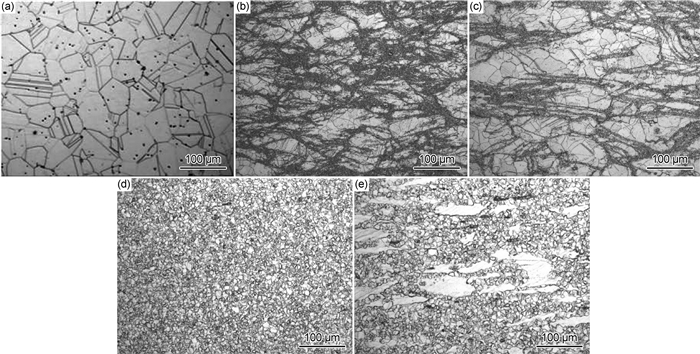
|
图 1 GH4169合金微观组织 (a)原棒料;(b)30%断面收缩率轧件表层;(c)30%断面收缩率轧件心部;(d)50%断面收缩率轧件表层;(e)50%断面收缩率轧件心部 Fig. 1 Microstructures of GH4169 alloy (a)original bar; (b)surface of the rolled pieces with area reduction of 30%; (c)core of the rolled pieces with area reduction of 30%;(d)surface of the rolled pieces with area reduction of 50%; (e)core of the rolled pieces with area reduction of 50% |
采用电子背散射衍射技术(EBSD)对GH4169合金楔横轧件的动态再结晶进行分析。图 2(a)~(d)为Channel 5软件重构得到的30%, 50%断面收缩率下轧件表层和心部的动态再结晶分布图,图 2中蓝色为再结晶晶粒,黄色为亚结构,红色为变形晶粒。图 3为合金动态再结晶体积分数柱状图。从图 2中可以看出,轧件表层的动态再结晶体积分数明显高于轧件心部,30%断面收缩率下轧件表层微观组织以再结晶晶粒和亚结构为主,心部以亚结构和变形晶粒为主,轧件表层和心部平均晶粒尺寸分别为7.59, 16.15 μm;50%断面收缩率下轧件表层显微组织为再结晶晶粒,再结晶晶粒体积分数达到95%,已发生完全动态再结晶,心部除再结晶晶粒和亚结构之外,还存在少量的变形晶粒,轧件表层和心部平均晶粒尺寸分别为8.25, 9.46 μm。采用DEFORM-3D有限元软件分析楔横轧加工过程,其有限元模型如图 4所示,热力耦合参数见表 3,利用有限元软件后处理的点跟踪功能导出轧件径向不同位置(A, B, C, D)的等效应变随轧制时间的变化规律,如图 5所示,从图 5可以看出,楔横轧加工过程中变形量由表层向心部逐渐减小,表层先达到发生动态再结晶的临界应变,从而发生动态再结晶,而心部最后达到再结晶的临界应变。当断面收缩率较小时,轧件尚未发生完全动态再结晶轧制过程即结束,导致显微组织中存在大量的亚结构和变形晶粒,随着断面收缩率的增加,轧件的“轧透”性增加,即轧件心部的变形量达到发生动态再结晶所需的临界应变,动态再结晶体积分数增加。

|
图 2 GH4169合金楔横轧件动态再结晶 (a)30%断面收缩率表层;(b)30%断面收缩率心部;(c)50%断面收缩率表层;(d)50%断面收缩率心部 Fig. 2 Dynamic recrystallization of GH4169 alloy during cross wedge rolling (a)surface of the rolled pieces with area reduction of 30%;(b)core of the rolled pieces with area reduction of 30%; (c)surface of the rolled pieces with area reduction of 50%;(d)core of the rolled pieces with area reduction of 50% |
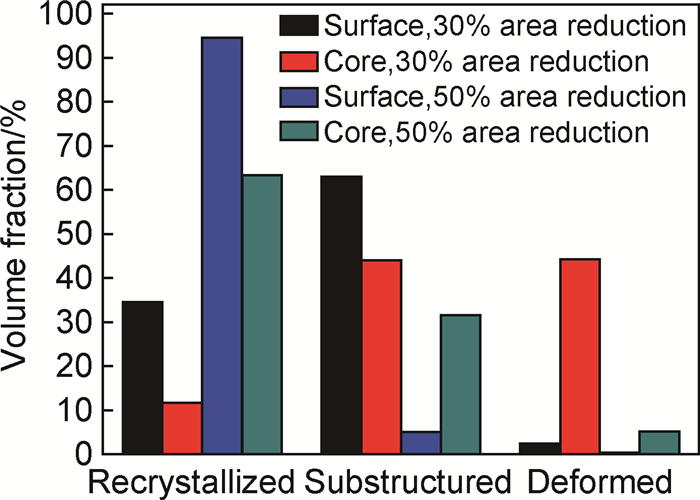
|
图 3 GH4169合金楔横轧件动态再结晶体积分数 Fig. 3 Dynamic recrystallization volume fraction of GH4169 alloy during cross wedge rolling |

|
图 4 楔横轧模型 Fig. 4 Cross wedge rolling model |
| Heat transfer coefficient/ (W·m-2·K-1) | Convective heat transfer coefficient/(W·m-2·K-1) | Thermal conversion coefficient | Friction factor | Trellis partition number |
| 1311.4 | 200 | 0.9 | 2 | 80000 |
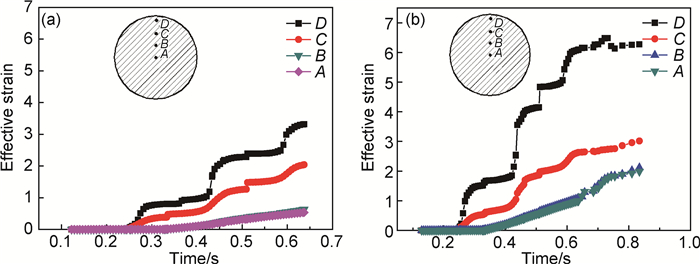
|
图 5 等效应变随时间变化规律 (a)断面收缩率30%;(b)断面收缩率50% Fig. 5 Variation of effective strain with time (a)area reduction of 30%;(b)area reduction of 50% |
图 6为原棒料和断面收缩率为30%, 50%楔横轧试样表层与心部的EBSD全Euler图。图 6中不同颜色晶粒表示晶体取向不同。将不同取向的晶粒绘制于反极图中,观察不同取向的晶粒在反极图中的分布规律。从图 6可以看出,在本次实验工艺条件下,轧件表层和心部晶粒取向变化规律不同。原棒料的晶粒取向呈随机分布(见图 6(a));30%断面收缩率下轧件表层晶粒取向表现出一定的随机性(见图 6(b)),轧件心部晶粒取向有一定的趋向性,晶粒取向为〈001〉和〈111〉(见图 6(c));50%断面收缩率下轧件表层各晶粒取向呈随机分布(见图 6(d)),轧件心部晶粒取向有一定的趋向性,晶粒取向为〈101〉(见图 6(e))。这主要与楔横轧加工过程中GH4169合金微观组织演变规律有关(见图 1)。
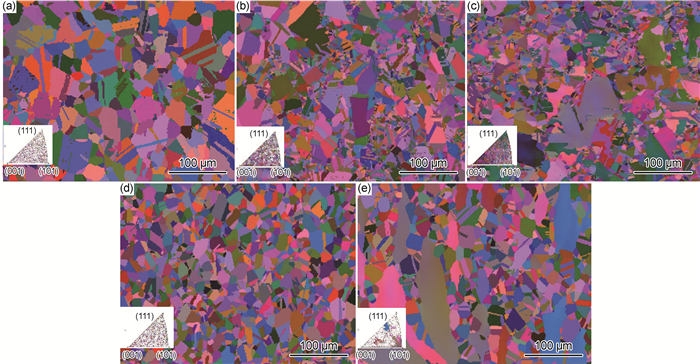
|
图 6 楔横轧GH4169合金全Euler图 (a)原棒料;(b)30%断面收缩率轧件表层;(c)30%断面收缩率轧件心部;(d)50%断面收缩率轧件表层;(e)50%断面收缩率轧件心部 Fig. 6 All Euler maps of GH4169 alloy during cross wedge rolling (a)original bar; (b)surface of the rolled pieces with area reduction of 30%;(c)core of the rolled pieces with area reduction of 30%; (d)surface of the rolled pieces with area reduction of 50%;(e)core of the rolled pieces with area reduction of 50% |
图 7为不同断面收缩率下轧件表层及心部位置的极图。图 7(a)为原棒料的极图;图 7(b)~(e)分别为30%和50%断面收缩率轧件的表层和心部极图。从图 7可以看出,30%和50%断面收缩率下GH4169合金楔横轧过程中轧件的织构强度发生了变化。30%和50%断面收缩时轧件表层织构强度变化很小,而轧件心部织构强度(图 7(c), (e))明显增大。这是由于再结晶的发生使晶粒取向逐渐变得随机,轧件表层晶粒取向呈随机分布,其表层织构强度变化较小;轧件心部晶粒发生转动,晶粒取向有一定的趋向性,进而导致织构增强。

|
图 7 GH4169合金楔横轧件极图 (a)原棒料;(b)30%断面收缩率轧件表层;(c)30%断面收缩率轧件心部;(d)50%断面收缩率轧件表层;(e)50%断面收缩率轧件心部 Fig. 7 Pole figures of GH4169 alloy during cross wedge rolling (a)original bar; (b)surface of the rolled pieces with area reduction of 30%;(c)core of the rolled pieces with area reduction of 30%; (d)surface of the rolled pieces with area reduction of 50%; (e)core of the rolled pieces with area reduction of 50% |
不同轧制条件下GH4169合金楔横轧件φ2=45°三维取向(ODF)和主要织构取向如图 8所示,已有研究表明[18-19], 黄铜型织构{001}〈112〉和铜型织构{112}〈111〉为FCC结构金属在轧制变形过程中的稳定取向,轧制过程中晶粒取向会朝这两个方向发生偏转。从图 8(a)可以看出,GH4169合金原棒料存在{001}〈110〉, {111}〈110〉, {111}〈011〉织构类型。当断面收缩率为30%时(见图 8(b), (c)),轧件表层主要织构类型为{112}〈110〉, {110}〈112〉织构类型,轧件心部的主要织构类型为{112}〈110〉;当断面收缩率达到50%时(见图 8(d), (e)),轧件表层主要织构类型为{001}〈010〉, {112}〈110〉, {110}〈111〉,轧件心部主要织构类型为{112}〈110〉, {110}〈112〉。
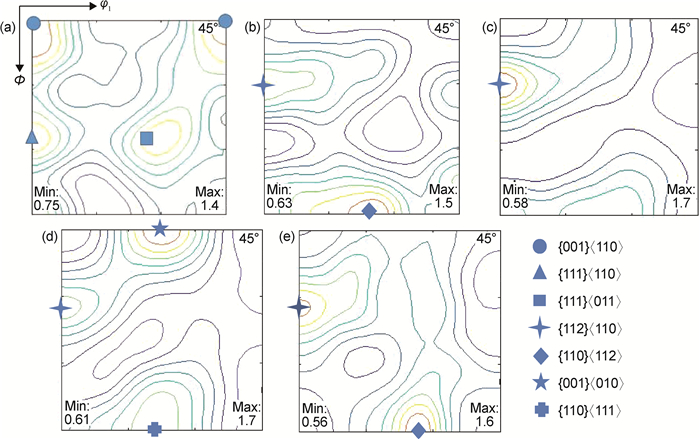
|
图 8 GH4169合金楔横轧件φ2=45°三维取向图(ODF)及主要织构类型 (a)原棒料;(b)30%断面收缩率轧件表层;(c)30%断面收缩率轧件心部;(d)50%断面收缩率轧件表层;(e)50%断面收缩率轧件心部 Fig. 8 φ2=45° section of ODF and typical texture of GH4169 alloy during cross wedge rolling (a)original bar; (b)surface of the rolled pieces with area reduction of 30%;(c)core of the rolled pieces with area reduction of 30%; (d)surface of the rolled pieces with area reduction of 50%;(e)core of the rolled pieces with area reduction of 50% |
经过大塑性变形后,晶粒会发生破碎,晶界数量明显增加,晶界角度是表征晶界特性的手段之一[20]。不同工艺条件下GH4169合金楔横轧加工过程中晶体取向发生变化,不同断面收缩率下轧件取向差分布如图 9所示,取向差大于15°的晶界为大角度晶界(high-angle grain boundaries, HAGBs),取向差角小于10°的晶界为小角度晶界(low-angle grain boundaries, LAGBs)。从图 9(b), (c)计算可得,30%断面收缩率时,楔横轧件小角度晶界数量明显增加,轧件心部小角度晶界占比63.6%,显著高于轧件表层的17.2%;从图 9(d), (e)计算可得,50%断面收缩率时,轧件心部小角度晶界占比16.3%,仍然明显大于轧件表层的2.5%;从图 9(f)可以看出,随着断面收缩率的增加轧件同一位置的大角度晶界数量增加,小角度晶界数量减少;沿轧件径向由表层至心部大角度晶界数量减少,小角度晶界数量增多。这与楔横轧的局部渐进成形特点有关,随着断面收缩率的增加,轧件的轧透性增加即轧件心部的变形量达到发生动态再结晶所需的临界应变,动态再结晶体积分数增加消耗大量的位错[21-22],从而导致轧件心部小角度晶界数量大于轧件表层,且小角度晶界数量随着断面收缩率增加而减少。
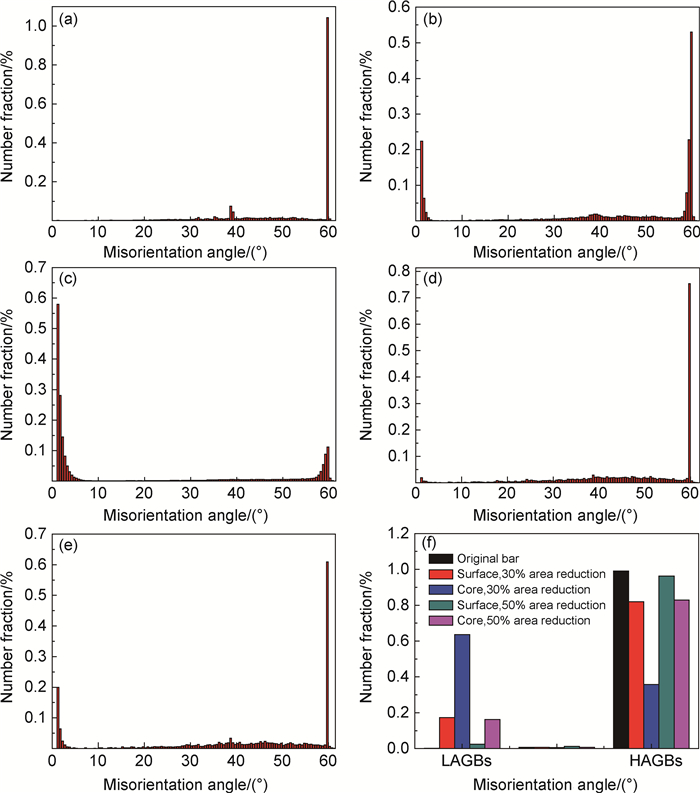
|
图 9 GH4169合金楔横轧件取向差分布 (a)原棒料;(b)30%断面收缩率轧件表层;(c)30%断面收缩率轧件心部;(d)50%断面收缩率轧件表层;(e)50%断面收缩率轧件心部;(f)取向差角分布 Fig. 9 Distribution of misorientation angle of GH4169 alloy during cross wedge rolling (a)original bar; (b)surface of the rolled pieces with area reduction of 30%;(c)core of the rolled pieces with area reduction of 30%; (d)surface of the rolled pieces with area reduction of 50%;(e)core of the rolled pieces with area reduction of 50%; (f)distribution of misorientation angle |
图 10为楔横轧加工过程中轧件受力状态图。可以看出,楔横轧成形过程中试件是在交变载荷的作用下成形,在楔入段和展宽段,试件与模具接触的轧件表层受三向压应力作用,而未与模具接触的轧件表层和轧件心部受两向拉应力和一向压应力作用;而成形段轧件表层和心部只受沿轴向的拉应力作用。晶粒在成形过程中轴向拉应力和径向压应力的作用下拉长,变形量达到发生动态再结晶的临界应变时即发生了动态再结晶,并且生成均匀细小的等轴晶粒,动态再结晶体积分数越大,晶粒的取向随机分布趋向越强。
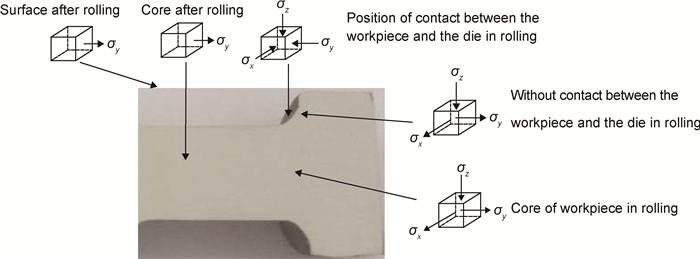
|
图 10 楔横轧过程中轧件受力状态分析 Fig. 10 Analysis of force state of rolled pieces in cross wedge rolling process |
(1) 楔横轧加工变形量的分布特点影响了GH4169合金楔横轧前后的微观组织特征,30%断面收缩率下轧件表层和心部平均晶粒尺寸分别为7.59, 16.15 μm,轧件表层与心部微观组织差异较大,混晶特征明显;50%断面收缩率下轧件表层和心部平均晶粒尺寸分别为8.25, 9.46 μm,轧件表层到心部组织更加均匀,增大断面收缩率有利于获得组织均匀的再结晶晶粒。
(2) GH4169合金楔横轧加工过程中晶粒朝有利于变形的取向转动,轧制过程中生成的亚结构和变形晶粒表现出一定的取向性,动态再结晶的发生导致晶体取向逐渐变得随机化分布。
(3) 楔横轧加工过程中晶体取向发生变化,导致织构也发生了变化,断面收缩率为30%和50%时,轧件心部织构强度明显增强,而轧件表层织构强度变化不大;原始棒料织构类型以{001}〈110〉, {111}〈110〉, {111}〈011〉为主,经楔横轧后轧件织构类型以{112}〈110〉, {110}〈112〉为主。
(4) 不同轧制变形量下的晶界角度变化反映了晶界特性,30%断面收缩率楔横轧件小角度晶界数量明显增加,且轧件心部小角度晶界占比63.6%, 显著高于轧件表层的17.2%;当断面收缩率增加到50%时,轧件心部小角度晶界占比16.3%, 仍然明显大于轧件表层的2.5%。
| [1] |
刘臣, 田素贵, 王欣, 等. 一种GH4169镍基合金的组织结构与蠕变性能[J]. 材料工程, 2017, 45(6): 43-48. LIU C, TIAN S G, WANG X, et al. Microstructure and creep property of a GH4169 nickel-based superalloy[J]. Journal of Materials Engineering, 2017, 45(6): 43-48. |
| [2] |
韩大尉, 孙文儒, 于连旭, 等. Mo含量对IN718合金组织和力学性能的影响[J]. 航空材料学报, 2018, 38(4): 64-74. HAN D W, SUN W R, YU L X, et al. Effect of Mo content on microstructure and mechanical properties of IN718 alloy[J]. Journal of Aeronautical Materials, 2018, 38(4): 64-74. |
| [3] |
ZHANG H Y, ZHANG S H, CHENG M, et al. Deformation characteristics of δ phase in the delta-processed Inconel 718 alloy[J]. Materials Characterization, 2010, 61(1): 49-53. DOI:10.1016/j.matchar.2009.10.003 |
| [4] |
MEI Y P, LIU Y C, LIU C X, et al. Effects of cold rolling on the precipitation kinetics and the morphology evolution of intermediate phases in Inconel 718 alloy[J]. Journal of Alloys and Compounds, 2015, 649: 949-960. DOI:10.1016/j.jallcom.2015.07.149 |
| [5] |
WANG Y, ZHEN L, SHAO W Z, et al. Hot working characteristics and dynamic recrystallization of delta-processed superalloy 718[J]. Journal of Alloys and Compounds, 2009, 474(1/2): 341-346. |
| [6] |
LIN Y C, WU X Y, CHEN X M, et al. EBSD study of a hot deformed nickel-based superalloy[J]. Journal of Alloys and Compounds, 2015, 640: 101-113. DOI:10.1016/j.jallcom.2015.04.008 |
| [7] |
SUI F L, ZUO Y, LIU X H, et al. Microstructure analysis on IN 718 alloy round rod by FEM in the hot continuous rolling process[J]. Applied Mathematical Modelling, 2013, 37(20/21): 8776-8784. |
| [8] |
叶能永.冷轧变形诱导GH4169合金再结晶和相析出机理及其应用[D].沈阳: 中国科学院大学, 2016. YE N Y.Research on the mechanism and application of recrystallization and phase precipitation of GH4169 alloy induced by cold rolling[D].Shenyang: University of Chinese Academy of Sciences, 2016. http://www.wanfangdata.com.cn/details/detail.do?_type=degree&id=Y3105296 |
| [9] |
HUO Y M, BAI Q, WANG B Y. A new application of unified constitutive equations for cross wedge rolling of a high-speed railway axle steel[J]. Journal of Materials Processing Technology, 2015, 223: 274-283. DOI:10.1016/j.jmatprotec.2015.04.011 |
| [10] |
URANKAR S, LOVELL M, MORROW C, et al. Development of a critical friction model for cross wedge rolling hollow shafts[J]. Journal of Materials Processing Technology, 2006, 177(1/3): 539-544. |
| [11] |
PENG W F, ZHENG S H, CHIU Y J, et al. Multi-wedge cross wedge rolling process of 42CrMo4 large and long hollow shaft[J]. Rare Metal Materials and Engineering, 2016, 45(4): 836-842. DOI:10.1016/S1875-5372(16)30084-4 |
| [12] |
赵培峰.6061铝合金楔横轧变形研究[D].北京: 机械科学研究总院, 2006. ZHAO P F.Study of deformation of 6061 aluminium alloy in the process of cross wedge rolling[D].Beijing: China Academy of Machinery Science and Technology, 2006. http://cdmd.cnki.com.cn/Article/CDMD-82701-2006180743.htm |
| [13] |
ZHANG N, WANG B Y, LIN J G. Effect of cross wedge rolling on the microstructure of GH4169 alloy[J]. International Journal of Minerals, Metallurgy and Materials, 2012, 19(9): 836-842. DOI:10.1007/s12613-012-0636-9 |
| [14] |
张宁, 王宝雨. 楔横轧不同变形阶段的微观组织演变分析[J]. 塑性工程学报, 2012, 19(1): 16-20. ZHANG N, WANG B Y. Analysis of microstructural evolution during different stages of cross wedge rolling[J]. Journal of Plasticity Engineering, 2012, 19(1): 16-20. DOI:10.3969/j.issn.1007-2012.2012.01.004 |
| [15] |
张宁, 王宝雨, 胡正寰. 楔横轧成形GH4169合金的热力耦合数值模拟[J]. 北京科技大学学报, 2011, 33(11): 1396-1401. ZHANG N, WANG B Y, HU Z H. Thermomechanical coupled simulation of GH4169 alloy for cross wedge rolling[J]. Journal of University of Science and Technology Beijing, 2011, 33(11): 1396-1401. |
| [16] |
CHEN Y, GAN H Y, ZHANG S H, et al. Analysis of deformation and internal defect in flat-wedge cross-wedge rolling of GH4169 superalloy[J]. Materials Science Forum, 2016, 879: 324-329. DOI:10.4028/www.scientific.net/MSF.879.324 |
| [17] |
朱德彪, 束学道. 工艺参数对楔横轧GH4169合金轴类件力能参数的影响[J]. 塑性工程学报, 2018, 25(1): 52-59. ZHU D B, SHU X D. Influence of process parameters on force and energy parameters of cross wedge rolling GH4169 alloy shaft parts[J]. Journal of Plasticity Engineering, 2018, 25(1): 52-59. |
| [18] |
SIDOR J J, KESTENS L A I. Analytical description of rolling textures in face-centred-cubic metals[J]. Scripta Materialia, 2013, 68(5): 273-276. DOI:10.1016/j.scriptamat.2012.10.039 |
| [19] |
HIRSCH J, LUCKE K. Mechanism of deformation and development of rolling texture in polycrystalline FCC metals[J]. Acta Metallurgica, 1988, 36(11): 2863-2927. DOI:10.1016/0001-6160(88)90172-1 |
| [20] |
史庆南, 陈亮维, 王晓琪. 大塑性变形及材料微结构表征[M]. 北京: 科学出版社, 2016. SHI Q N, CHEN L W, WANG X Q. Characterization of sever plastic deformation and microstructure of materials[M]. Beijing: Science Press, 2016. |
| [21] |
HUANG K, LOGE R E. A review of dynamic recrystallization phenomena in metallic materials[J]. Materials & Design, 2016, 111: 548-574. |
| [22] |
朱怀沈, 聂义宏, 赵帅, 等. 镍基617合金动态再结晶微观组织演变与预测[J]. 材料工程, 2018, 46(6): 80-87. ZHU H S, NIE Y H, ZHAO S, et al. Microstructure evolution and prediction of alloy 617 during hot deformation based on dynamic recrystallization[J]. Journal of Materials Engineering, 2018, 46(6): 80-87. |
 2020, Vol. 48
2020, Vol. 48


